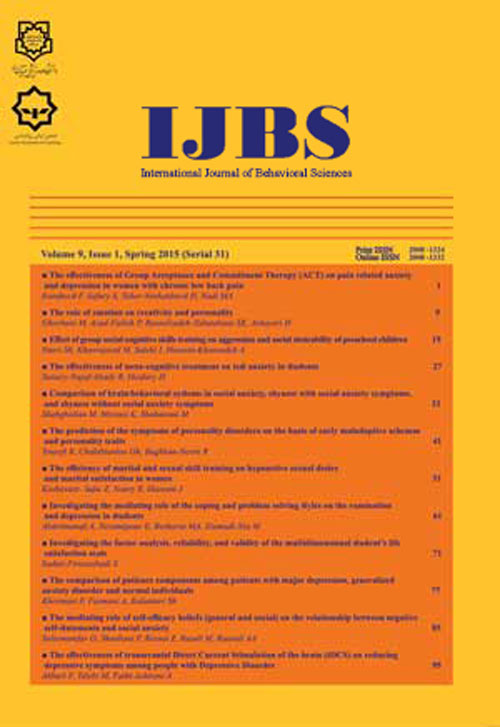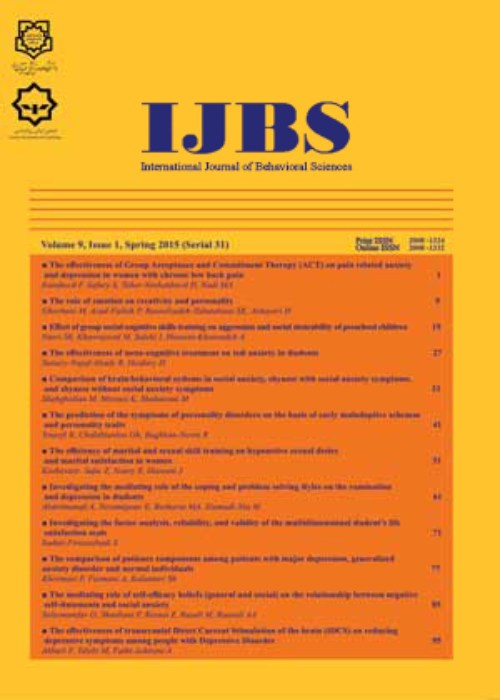فهرست مطالب

International Journal of Behavioral Sciences
Volume:14 Issue: 1, Spring 2020
- تاریخ انتشار: 1399/03/20
- تعداد عناوین: 8
-
-
Pages 1-5IntroductionSpiritual health has a substantial effect on other aspects of health. Due to the important role of university students in the development of a country, it is necessary to examine the correlates of different dimensions of health using appropriate tools in this community. This study aimed to determine the role of demographic variables in the spiritual health of the students of Iran University of Medical Sciences.MethodIn this descriptive and cross-sectional study, the statistical sample comprised 473 students selected by convenience sampling method. To collect data, a researcher-made demographic questionnaire and the spiritual health questionnaire, which has been developed by Amiri et al., were used. The collected data were analyzed through SPSS software.ResultsAccording to the Mann-Whitney U test, there was a significant difference between the mean scores of spiritual health in women (78.51) and men (70.41). This difference was also significant between married (80.42) and single (74.81) students. This is while there was no significant differences between various groups in terms of other demographic factors.ConclusionIt can be concluded that women and married students have higher spiritual health in comparison to men and single ones. This is while other demographic variables such as age, education, employment position, and place of residence could not predict the level of spiritual health in university students.Keywords: Demographic Factor, Spirituality, Students, Iran
-
Pages 6-12introduction
Social anxiety is a prevalent disorder among university students which interferes with their functions. Mindfulness-based cognitive therapy is one of the new approaches for treating psychological disorders. This research aims to study the effectiveness of group mindfulness-based cognitive therapy in university students suffering from social anxiety.
MethodThe design of this study was quasi-experimental with pretest, posttest and follow-up assessments for control and intervention groups. For this purpose, 24 students diagnosed with social anxiety were randomly allocated to control and intervention groups. The intervention group received 8 sessions of mindfulness-based cognitive therapy. The students completed the Social Interaction Anxiety Scale (SIAS), Interpersonal Sensitivity Measure (IPSM) and the Self-Compassion Scale (SCS) in both pretest and posttest. Follow-up assessments were done after 2 months. The data were analyzed using SPSS.
ResultsAccording to the findings of the present study, mindfulness-based cognitive therapy reduces social anxiety and interpersonal sensitivity significantly. Also, it can increase the components of self-compassion significantly in the intervention group compared to the control group.
ConclusionDue to the effectiveness of mindfulness-based cognitive therapy in reducing social anxiety in students, considering and utilizing this kind of psychotherapy is of great importance.
Keywords: Mindfulness-based Cognitive Therapy, social anxiety, interpersonal sensitivity, self-compassion -
Pages 13-19Introduction
The present study aimed to determine the effectiveness of organizational intelligence, workplace-life skills, and employee empowerment training on job satisfaction and organizational culture of employees with job stress in the Persian Gulf Star Oil Company (PGSOC).
MethodThe research method was quasi-experimental with a pretest-posttest design and a control group. The research sample consisted of 80 employees with job stress (20 employees in the experimental group 1 (organizational intelligence training), 20 in the experimental group 2 (workplace-life skills training), 20 in the experimental group 3 (employee empowerment training) and 20 in the control group). these employees were selected by a simple random sampling method. The research tools included Minnesota Job Satisfaction Questionnaire, Denison Organizational Culture Survey, and Rice Job Stress Questionnaire. Multivariate analysis of covariance (MANCOVA) and ANCOVA were used to analyze the data.
ResultsThe results indicated that organizational intelligence, workplace-life skills, and employee empowerment training increased job satisfaction and organizational culture in employees with job stress in experimental groups 1, 2 and 3 in comparison to the control group.
ConclusionOrganizational intelligence, workplace-life skills and empowerment training for employees could be effective in increasing job satisfaction and organizational culture.
Keywords: Organizational Intelligence, Workplace-life Skills, Empowerment, Job Satisfaction, Organizational Culture -
Pages 20-26Introduction
The increasing importance of the movement of positive psychology and consequently positive education has led scientific study to foster and promote human psychological flourishing. This research aimed to provide an educational-interventional protocol to foster and promote flourishing and evaluate its effectiveness.
MethodWith a pretest and posttest design and a control group, this study was performed on 34 teachers from two schools in Tehran, selected by multi-stage cluster sampling. After randomly allocating teachers to the test and control groups, they complete the Human Psychological Flourishing Scale and Flourishing Questionnaire. Then, the educational-interventional flourishing protocol was only presented to the test group during 14 sessions. The questionnaires were filled again by all the subjects at the end of the course.
ResultsAccording to the results of the univariate and multivariate covariance analyses, flourishing training significantly increased all the components of flourishing in the test group, compared to the control group.
ConclusionAccording to the results, the application of educational-interventional flourishing protocol increased all the components of flourishing among teachers (e.g., positive emotion, relationships, meaning, and accomplishment, sense of satisfaction/happiness, individual competency and social contribution). Therefore, this protocol can be applied to promote the flourishing of teachers.
Keywords: Positive Psychology, Human Flourishing, Educational-interventional Protocol -
Pages 27-33Introduction
Organizations are in constant endeavor to find ways to enhance their employees’ productivity and efficiency. In this context, the present study attempted to examine if mindfulness and perceived control of internal states along with major demographic variables act as indicators of work engagement in front-liner employees.
MethodIn this survey, 180 front-liners who were selected through purposive sampling from five private organizations participated. The Cognitive and Affective Mindfulness Scale-Revised, Perceived Control of Internal States Scale, and Utrecht Work Engagement Scale were administered. The obtained quantitative data were analyzed in terms of descriptive statistics, Pearson’s r, and multiple hierarchical regression analysis.
ResultsFindings revealed that out of the six predictors under study, five predictors—mindfulness, perceived control of internal states along with three demographic variables (age, marital status, and years of service)—were found to significantly correlate with employees work engagement.
ConclusionIt was observed that mindfulness was a significant predictor when it was considered solely as an indicator of work engagement. Nevertheless when other predictors were considered, perceived control of internal states was found to be a dominant indicator of work engagement across the models. The shortcomings, future directions, and implications were also discussed.
Keywords: Mindfulness, perceived control of internal state, work engagement, organization, front-line employees -
Pages 34-39Introduction
The present study was aimed to investigate if decision making styles can be predicted by emotion regulation and action control or not.
MethodThe Participants included 422 students (164 male and 258 female) of Shiraz University that were selected using a multistage random cluster sampling method. In order to gather the required data, General Decision Making Styles scale (Scott and Bruce, 1995), Emotion Regulation scale (John and Gross, 2003), and Action Control scale were used. Multiple regression (enter method) was used for analyzing the data.
ResultsResults indicated that the Avoidant and Rational, but not Intuitive decision making styles could be partly predicted by Emotion Regulation and Action Control. It is shown that Spontaneous and Dependent decision making styles can only be predicted using Action Control.
ConclusionAmong the variables of emotion regulation and action control, the strongest predictor for decision making styles is action control. Further research can examine the role of individual factors such as five personality factors as well as family variables in decision making.
Keywords: Decision Making Style, emotion regulation, Action Control -
Pages 40-44introduction
Multiple Sclerosis (MS) is an incapacitating neurological disease with diverse signs, consisting of difficult or unclear articulation of speech and cognitive and linguistic deficits. The purpose of this study was to compare the cognitive and linguistic functions among MS individuals and healthy controls.
MethodThe present descriptive and cross-sectional study was performed at Shahid Motahari Clinic of Shiraz, Iran, in 2018-2019. The participants were selected by using a purposeful sampling method from September 2018 to December 2018, at the MS centers of neurology departments. The Persian aphasia test was used as the research instrument to evaluate the cognitive functions in MS patients. The data were analyzed using the SPSS version 23 software.
ResultsThe results of the present study revealed that the processing of all subscales, except for transcription, letter and word dictation, and sentence dictation, were significantly different between healthy and unhealthy individuals. Moreover, the results showed that the production of the focused sentence were worse in unhealthy individuals compared to healthy individuals (P < 0.05).
ConclusionThe results of this study showed that patients with MS were involved in linguistic and cognitive problems. Language and speech therapists who interact with these patients need to be aware of cognitive-linguistic disorders and consider this in their assessment, management, and intervention.
Keywords: Multiple Sclerosis, Cognitive Functions, Persian aphasia test -
Pages 45-50IntroductionThe study aims to examine the big five personality (Dimensions) as a mediator between Parental Psychological Control (PPC) and Difficulties in Emotion Regulation (DER). It was also researched that child characteristics moderate the effects of parenting outcomes.MethodThree hundred adolescents studying in different schools in Delhi were selected based on the random sampling technique. Three scales, namely Psychological Control Scale—Youth Self-Report (PCS-YSR), Big Five Inventory (BFI), and Difficulties in Emotion Regulation Scale Short Form (DERS-SF) were administered. A dichotomous independent variable (named X1) was used in the research where PPC was divided into two groups 'Both High' group VS 'Others'.ResultsObtained scores were analyzed by using Parallel mediation analysis through PROCESS macro version 3.2.01 for SPSS created by Hayes in 2018. Results of the mediational analysis revealed that X1(Both High vs. Others) significantly predicted neuroticism, and X1, neuroticism, and openness significantly predicted DER. Total effect (c=3.78, p<.05) and direct effect (c=2.73, p<.05) were found to be significant. Indirect effects were obtained by the Bootstrapping method. Findings revealed a specific indirect effect of neuroticism to be significant (coeff. =.1075; LLCI-ULCI= .0077 to.2102).ConclusionNeuroticism significantly mediates the relationship between emotion regulation and PPC. It is necessary to incorporate both individual and environmental factors to understand emotional development processes. It is therefore suggested to develop interventions that not only helps adolescents to learn effective ways to regulate emotions but to also guide parents to cater to the child's emotional needs effectually.Keywords: Parental Psychological Control, personality, emotion regulation, adolescents


